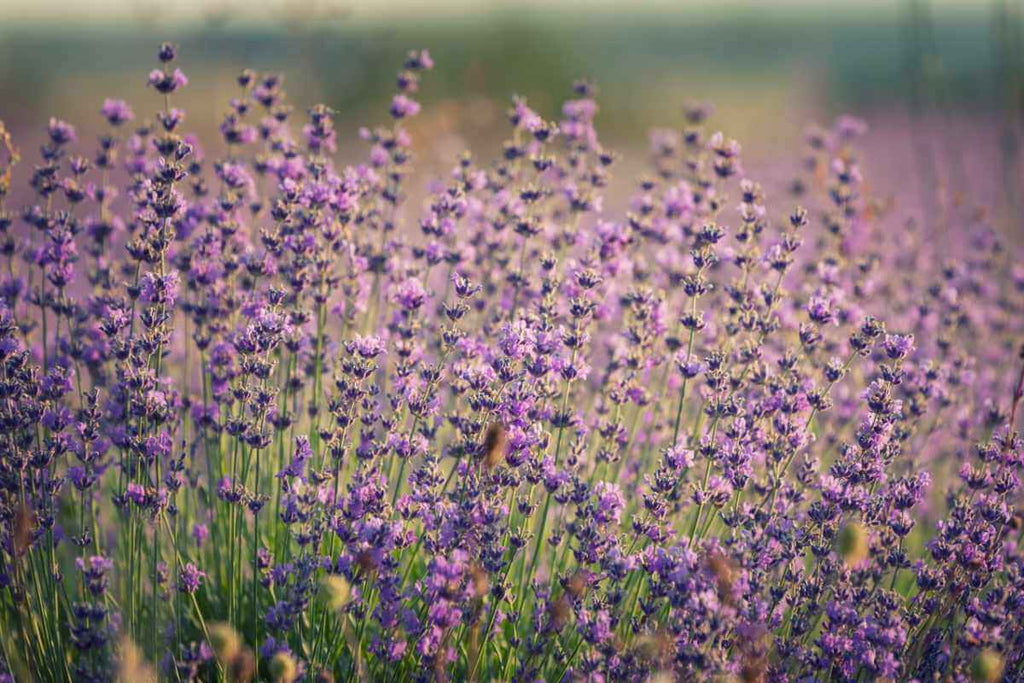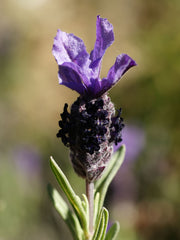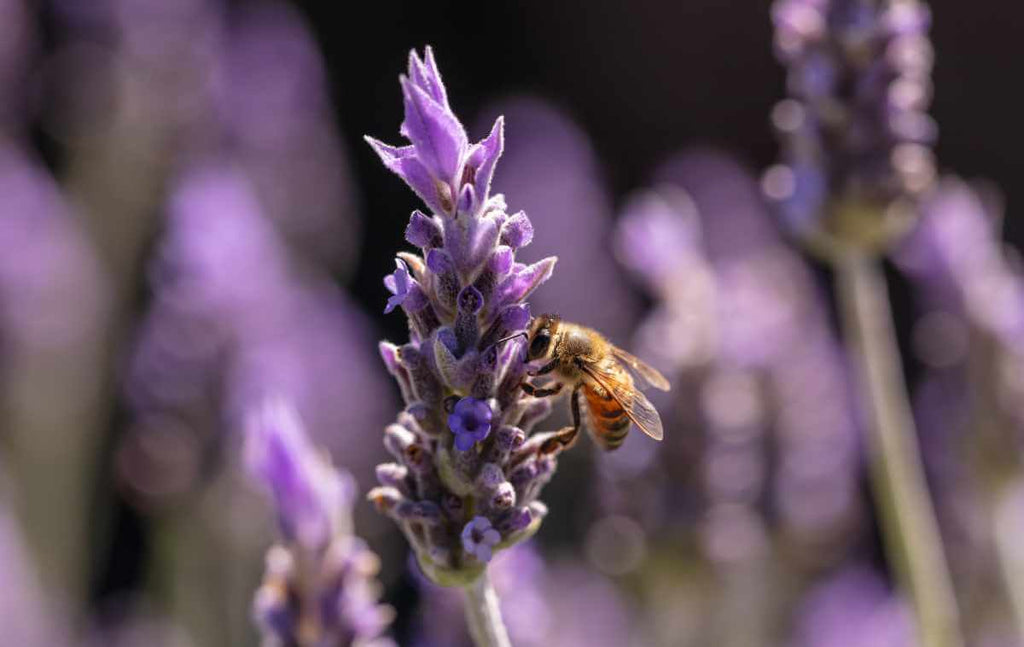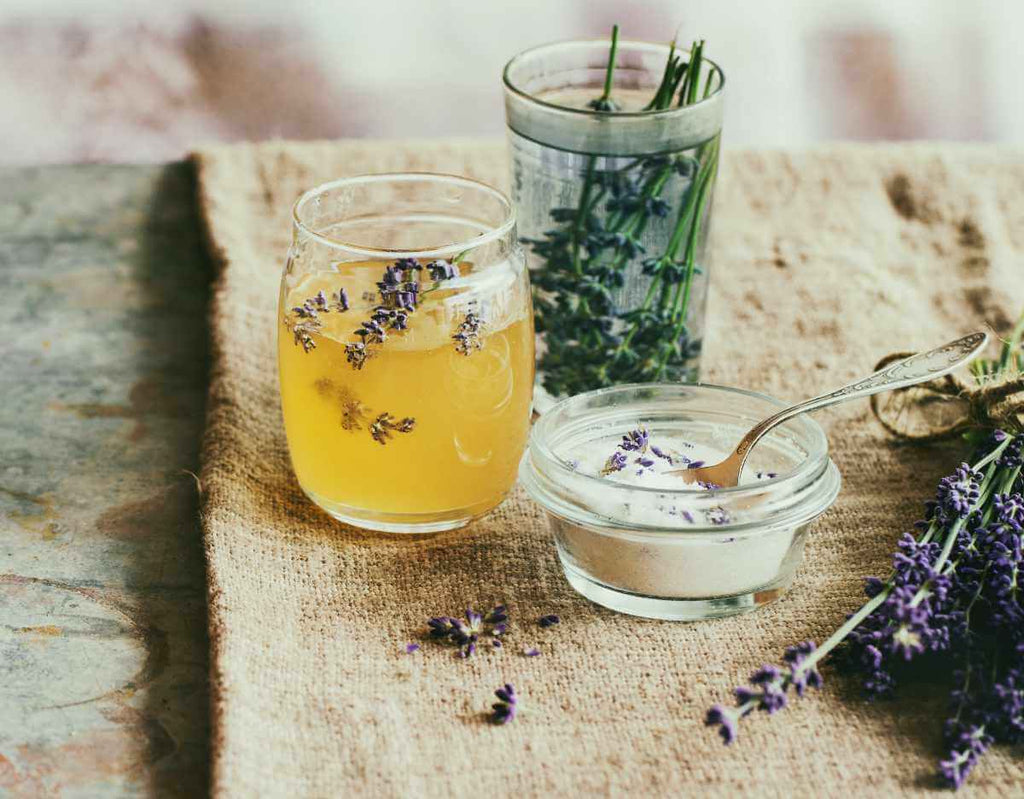
There are few plants we love as much as lavender. It suits almost every type of garden and has a timeless elegance that can’t be matched. It is as much at home in an urban courtyard in London as it is in the fields of Provence. Whether you have a windowsill or a country estate there is a lavender for you.
About lavender
Lavender (lavandula) is a genus of plants belonging to the mint family and is native to the Mediterranean. The strong scent is derived from oil glands on the trichomes (hairs) on the flowers, leaves and stems of the plants.
In Ancient Greece it was used to help cure insomnia and calm aches and pains. The Romans used lavender in their baths, and indeed the name lavender comes from the Latin lavare, to wash. It was believed to have healing qualities, and appears in many historical recipes for antiseptics, ointments, and cures for the plague. There is little evidence for the medicinal uses of lavender, but we still associate lavender with aiding sleep.
Lavandula comprises around 30 species and they are quite distinct in their uses, appearance, and growing habits, so it’s important to choose the right type. In the UK the most common species is lavandula angustifolia or English lavender. This is the variety used for commercial lavender production, making essential oils, and culinary purposes. Lavandula × intermedia, sometimes referred to as Dutch lavender, is a hybrid of lavandula angustifolia and lavandula latifola. It is considered slightly inferior to English lavender in quality of oil, but there are some beautiful varieties within this classification, including the classic white lavender, Edelweiss.  French lavender, or Lavandula stoechas, is an ornamental lavender that, although fragrant, does not have the strength or quality of scent of English lavender. French lavender is grown for its distinctive appearance as it has elegant bracts that grow from the top of the flower spike. French lavender is much less hardy than English, and is unlikely to survive a harsh winter. In London and other warm parts of the UK it can last a few years, but in most places it should be considered an annual.
French lavender, or Lavandula stoechas, is an ornamental lavender that, although fragrant, does not have the strength or quality of scent of English lavender. French lavender is grown for its distinctive appearance as it has elegant bracts that grow from the top of the flower spike. French lavender is much less hardy than English, and is unlikely to survive a harsh winter. In London and other warm parts of the UK it can last a few years, but in most places it should be considered an annual.
Other species available include Lavandula dentata, or fringed lavender, which has pretty toothed leaves, and Lavandula multifida, sometimes called Egyptian or fernleaf lavender, which often has very striking dark blue flowers. Neither Lavandula dentata or Lavandula multifida are hardy, and are tricky to get hold of in the UK. But there are a few stockists, and with some care you can grow them as an annual or in a conservatory.
Growing lavender
There are so many reasons to grow lavender! It's beautiful, fragrant, easy to maintain, bees and butterflies love it, and it will give you years of pleasure. You will have stunning flowers in the summer, and gorgeous silver foliage throughout the year.

English and Dutch lavender plants will last for many years and come in a range of colours from white to pinks, the classic ‘lavender’ to much richer dark blues. Hidcote (Lavandula angustifolia ‘Hidcot’) is one of the most popular varieties. It’s a compact plant, ideal for a low hedge. It’s a classic rich blue/purple and very hardy. Lavandula angustifolia ‘Munstead’ is another popular variety that is widely available. ‘Folgate’ is a good choice too. It tends to be a very fragrant with vibrant blue blooms. It flowers early in the season (early May) with repeat flowerings over the summer. The main variety of white English lavender is ‘Arctic Snow’, but we would recommend lavandula x intermedia ‘Edelweiss’ if you want white blooms. Lavandula angustifolia ‘Rosea’ is a very pretty pale pink, and look beautiful amongst contrasting blue and white varieties. Lavandula x intermedia are generally taller plants than English lavender, growing to around 80cm tall compared to the latter, which reach an average of 50 or 60cm.
French lavender is certainly more showy, and remember only half-hardy. 'Kew Red’ is particularly unusual, boasting rich burgundy flowers with white top bracts. ‘Regal Splendour’ has very elegant dark purple flowers with brighter purple bracts. French lavenders come in a huge range of colours and are very popular with pollinators, but remember the fragrance is poor compared to the English and Dutch varieties.
Although easy to maintain, lavender does best in full sun in well-drained soil. It’s great for drought-prone gardens, and in London that can be a real problem. English lavender can survive in temperatures as low as -15ºC but can really object to damp conditions. If your soil is quite heavy it’s a good idea to add some horticultural grit to help the drainage when you plant your lavender. French lavender is best planted in a pot, but other varieties can be potted too. You will need to ensure there is good drainage in your pots and they generally do best if you plant between March and May.
In late summer or early autumn (after flowering) you will need to prune you English lavender because it can become leggy and woody. For everything you need to know about caring for lavender check out the RHS.
Culinary uses for lavender
A few years ago lavender appeared in every other dish on Masterchef, and then just as quickly disappeared. Lavender is not a staple herb that can be added to any dressing or salad, but when used in the right place it’s delicious. Both the leaves and the flowers are edible and tasty, but the majority of recipes seem to use only the flowers.

Firstly there’s lavender shortbread, which is the perfect accompaniment to a cup of Earl Grey on a summer’s afternoon. And speaking of summer afternoons, a lavender martini may be more to your taste. Lavender goes wonderfully with lemon - it can be added to most lemony cakes (be careful of quantities however), and a homemade lavender lemonade is heavenly. Lavender goes very well as a flavouring for dairy desserts including panna cotta and ice cream. We’d also recommend this delight from Ottolenghi: Apricot, walnut and lavender cake.
It doesn’t have to be sweet. Used sparingly in marinades for meat it is delicious and pairs particularly well with lemony chicken or roast lamb. When using lavender in cooking, it’s really important to err on the side of caution to avoid a soapy flavour. And talking of soapy...
Fragrance
Since ancient times people have been distilling the oil from lavender flowers to create fragrances and cosmetics and it still one of the most used oils for toiletries. After all, the scent of lavender can trigger some wonderful recollections. Returning from work on a summer’s evening, brushing past the lavender on the path is a beautiful experience. The fragrance is stunning and will forever be associated with hot summers, here in the city or on holiday in France. With Bramley’s bath salts, which contain lavender flowers, you can relax like the Romans did and then light one of True Grace’s ‘English Lavender’ candles for perfect relaxation. Whatever the science is on the calming properties of lavender it is undoubtedly a great addition to a hot bath after a long day in the garden.

As long as you chose a hardy variety, lavender involves very little maintenance brings so much pleasure. Whether you are creating a Provençal oasis, an English country garden, a modern minimalist courtyard or are limited to a bijou balcony, lavender should make an appearance!
